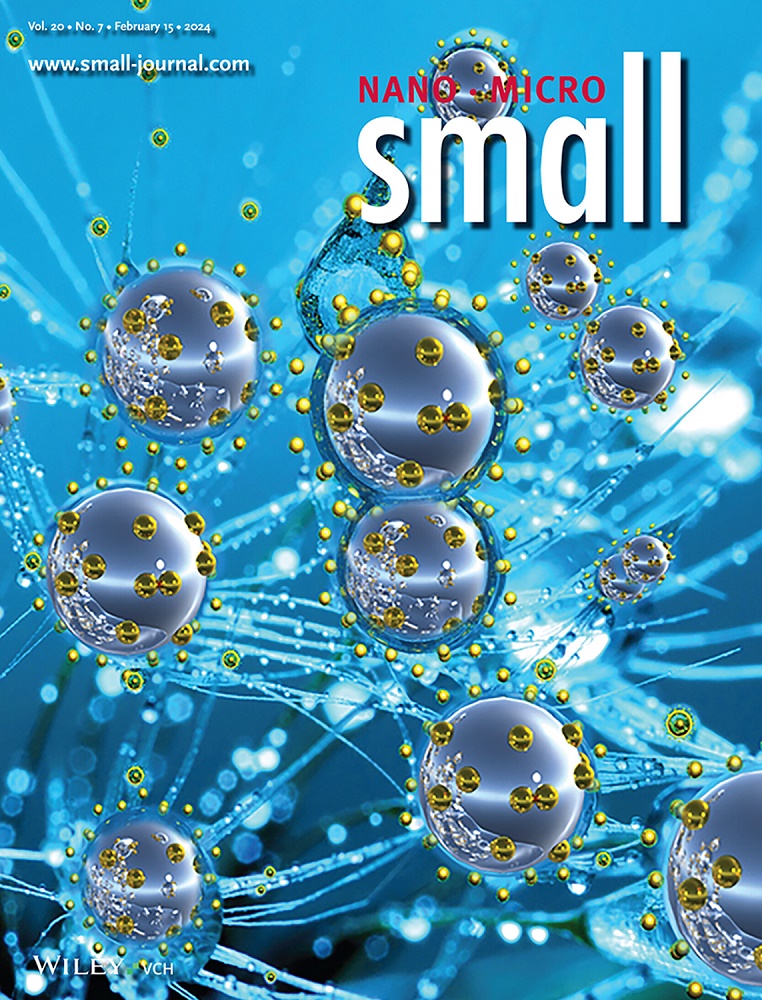Mutable Polarization Switching Characteristics in Wurtzite Al1- xScxN Ferroelectric Films Enabled by Sc-Doping.
IF 12.1
2区 材料科学
Q1 CHEMISTRY, MULTIDISCIPLINARY
引用次数: 0
Abstract
Wurtzite ferroelectric aluminum scandium nitrides (Al1- xScxN) are highly appealing for their large remanent polarization, steep hysteresis, and easy integration with multiple mainstream semiconductor platforms. However, their applications are constrained by the inherently high coercive field (Ec), desperately needing comprehensive research of polarization switching for potentially lowering Ec. In particular, the correlations between polarization switching mechanisms and Sc doping levels remain underexplored. Here, the polarization switching kinetics in wurtzite ferroelectric Al1- xScxN (x = 0.25-0.3) subjected to varied voltage amplitudes and pulse durations are investigated, revealing a mutable polarization switching. The Al0.75Sc0.25N sample displays uniform switching behavior described by the Kolmogorov-Avrami-Ishibashi (KAI) model, while the intermediate composition Al0.725Sc0.275N exhibits an ambiguous switching mechanism, more aligned with KAI model-based on mathematical fitting validation. Especially, Al0.7Sc0.3N with obviously reduced coercive and activation fields, exhibits a nucleation-limited-switching (NLS) mechanism. It is found that higher-level Sc doping generates more nucleation sites, reducing energy barriers and accelerating nucleation switching, driving the transition from KAI to NLS. Energetic analysis further elucidates the doping-induced crossover of switching mechanisms. These results provide new insight into the fundamental understanding of polarization switching in wurtzite ferroelectric nitrides, which is critical for realizing their optimal and reliable applications.sc掺杂使纤锌矿Al1- xScxN铁电薄膜的可变极化开关特性。
纤锌矿铁电性氮化铝钪(Al1- xScxN)具有较大的剩余极化、较大的迟滞、易于与多种主流半导体平台集成等优点。然而,它们的应用受到固有的高矫顽力场(Ec)的限制,迫切需要对极化开关进行全面的研究,以潜在地降低Ec。特别是,极化开关机制与Sc掺杂水平之间的相关性仍未得到充分研究。本文研究了纤锌矿铁电Al1- xScxN (x = 0.25-0.3)在不同电压幅值和脉冲持续时间下的极化开关动力学,揭示了一种可变的极化开关。Al0.75Sc0.25N样品表现出由Kolmogorov-Avrami-Ishibashi (KAI)模型描述的均匀开关行为,而中间组分Al0.725Sc0.275N表现出模糊的开关机制,更符合基于数学拟合验证的KAI模型。特别是Al0.7Sc0.3N的矫顽力和活化场明显减小,表现出核限开关(NLS)机制。研究发现,高能级Sc掺杂产生更多的成核位,降低了能垒,加速了成核转换,推动了KAI向NLS的转变。能量分析进一步阐明了掺杂诱导的开关交叉机制。这些结果对纤锌矿铁电氮化物的极化开关的基本理解提供了新的见解,这对于实现其最佳和可靠的应用至关重要。
本文章由计算机程序翻译,如有差异,请以英文原文为准。
求助全文
约1分钟内获得全文
求助全文
来源期刊

Small
工程技术-材料科学:综合
CiteScore
17.70
自引率
3.80%
发文量
1830
审稿时长
2.1 months
期刊介绍:
Small serves as an exceptional platform for both experimental and theoretical studies in fundamental and applied interdisciplinary research at the nano- and microscale. The journal offers a compelling mix of peer-reviewed Research Articles, Reviews, Perspectives, and Comments.
With a remarkable 2022 Journal Impact Factor of 13.3 (Journal Citation Reports from Clarivate Analytics, 2023), Small remains among the top multidisciplinary journals, covering a wide range of topics at the interface of materials science, chemistry, physics, engineering, medicine, and biology.
Small's readership includes biochemists, biologists, biomedical scientists, chemists, engineers, information technologists, materials scientists, physicists, and theoreticians alike.
 求助内容:
求助内容: 应助结果提醒方式:
应助结果提醒方式:


